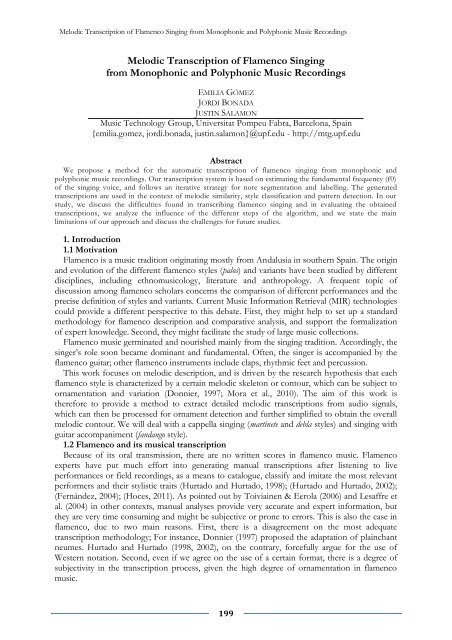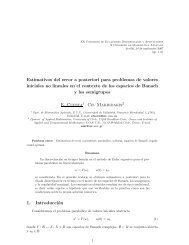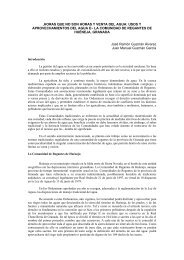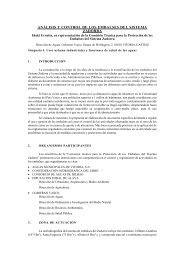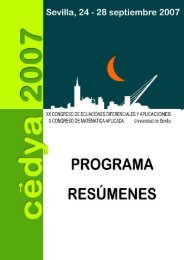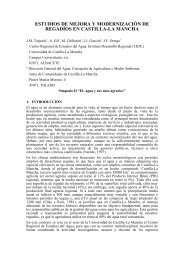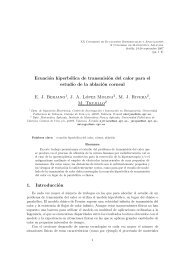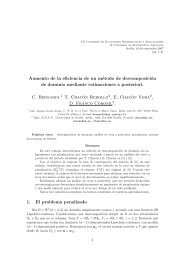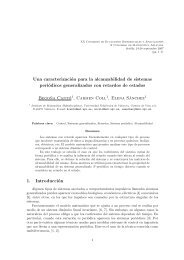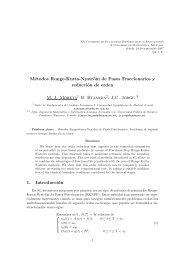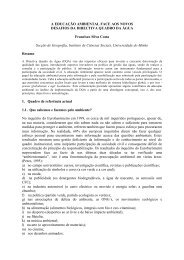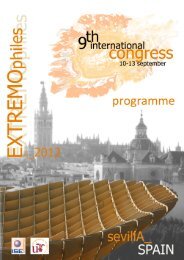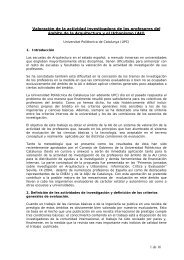LIBRO DE ACTAS (pdf) - Universidad de Sevilla
LIBRO DE ACTAS (pdf) - Universidad de Sevilla
LIBRO DE ACTAS (pdf) - Universidad de Sevilla
You also want an ePaper? Increase the reach of your titles
YUMPU automatically turns print PDFs into web optimized ePapers that Google loves.
Melodic Transcription of Flamenco Singing from Monophonic and Polyphonic Music Recordings<br />
Melodic Transcription of Flamenco Singing<br />
from Monophonic and Polyphonic Music Recordings<br />
EMILIA GÓMEZ<br />
JORDI BONADA<br />
JUSTIN SALAMON<br />
Music Technology Group, Universitat Pompeu Fabra, Barcelona, Spain<br />
{emilia.gomez, jordi.bonada, justin.salamon}@upf.edu - http://mtg.upf.edu<br />
Abstract<br />
We propose a method for the automatic transcription of flamenco singing from monophonic and<br />
polyphonic music recordings. Our transcription system is based on estimating the fundamental frequency (f0)<br />
of the singing voice, and follows an iterative strategy for note segmentation and labelling. The generated<br />
transcriptions are used in the context of melodic similarity, style classification and pattern <strong>de</strong>tection. In our<br />
study, we discuss the difficulties found in transcribing flamenco singing and in evaluating the obtained<br />
transcriptions, we analyze the influence of the different steps of the algorithm, and we state the main<br />
limitations of our approach and discuss the challenges for future studies.<br />
1. Introduction<br />
1.1 Motivation<br />
Flamenco is a music tradition originating mostly from Andalusia in southern Spain. The origin<br />
and evolution of the different flamenco styles (palos) and variants have been studied by different<br />
disciplines, including ethnomusicology, literature and anthropology. A frequent topic of<br />
discussion among flamenco scholars concerns the comparison of different performances and the<br />
precise <strong>de</strong>finition of styles and variants. Current Music Information Retrieval (MIR) technologies<br />
could provi<strong>de</strong> a different perspective to this <strong>de</strong>bate. First, they might help to set up a standard<br />
methodology for flamenco <strong>de</strong>scription and comparative analysis, and support the formalization<br />
of expert knowledge. Second, they might facilitate the study of large music collections.<br />
Flamenco music germinated and nourished mainly from the singing tradition. Accordingly, the<br />
singer’s role soon became dominant and fundamental. Often, the singer is accompanied by the<br />
flamenco guitar; other flamenco instruments inclu<strong>de</strong> claps, rhythmic feet and percussion.<br />
This work focuses on melodic <strong>de</strong>scription, and is driven by the research hypothesis that each<br />
flamenco style is characterized by a certain melodic skeleton or contour, which can be subject to<br />
ornamentation and variation (Donnier, 1997; Mora et al., 2010). The aim of this work is<br />
therefore to provi<strong>de</strong> a method to extract <strong>de</strong>tailed melodic transcriptions from audio signals,<br />
which can then be processed for ornament <strong>de</strong>tection and further simplified to obtain the overall<br />
melodic contour. We will <strong>de</strong>al with a cappella singing (martinete and <strong>de</strong>bla styles) and singing with<br />
guitar accompaniment (fandango style).<br />
1.2 Flamenco and its musical transcription<br />
Because of its oral transmission, there are no written scores in flamenco music. Flamenco<br />
experts have put much effort into generating manual transcriptions after listening to live<br />
performances or field recordings, as a means to catalogue, classify and imitate the most relevant<br />
performers and their stylistic traits (Hurtado and Hurtado, 1998); (Hurtado and Hurtado, 2002);<br />
(Fernán<strong>de</strong>z, 2004); (Hoces, 2011). As pointed out by Toiviainen & Eerola (2006) and Lesaffre et<br />
al. (2004) in other contexts, manual analyses provi<strong>de</strong> very accurate and expert information, but<br />
they are very time consuming and might be subjective or prone to errors. This is also the case in<br />
flamenco, due to two main reasons. First, there is a disagreement on the most a<strong>de</strong>quate<br />
transcription methodology; For instance, Donnier (1997) proposed the adaptation of plainchant<br />
neumes. Hurtado and Hurtado (1998, 2002), on the contrary, forcefully argue for the use of<br />
Western notation. Second, even if we agree on the use of a certain format, there is a <strong>de</strong>gree of<br />
subjectivity in the transcription process, given the high <strong>de</strong>gree of ornamentation in flamenco<br />
music.<br />
199


